- Home
- Anne McCaffrey
Sassinak Page 17
Sassinak Read online
Page 17
"Who assigns survey sectors?" asked Arly.
"I don't know, but I intend to find out." Huron had already put the cruiser on full stealth mode; Sassinak now tapped her own board into the Ssli biolink. Two more screens of data came up in front of her, highlighted for easy recognition. "But after we deal with this—and without getting killed. I have the feeling that their detection systems out here will be very, very good."
The ships they pursued had dropped out of FTL in the borders of a small star system: only five planets. The star itself was a nondescript little blip on the classification screen: small, dim, and, as Huron said, "as little there as a star can be." In that first few minutes, their instruments revealed three large clusters of mass on "this" side of the star—presumably planets or planet-systems toward one of which their quarry moved.
They were still days from any of them. Sassinak insisted that their first concern had to be the detection systems the slavers used. "They wouldn't assume anything: they'll have some way to detect ships that happen to blunder in here."
Huron frowned thoughtfully at the main display screen, now a shifting pattern of pale blues and greens as the Zaid-Dayan's passive scans searched for any signs of data transmission. "We can't hang around out here forever hunting for it—"
"No, we're going in. But I want to surprise them." Suddenly she grinned. "I think I know—did you ever live on a free-water world, Huron? Skip stones on water?"
"Yes, but—"
"Everyone sees the splash of the skips—and then the rock sinks, and disappears. We'll make sure they see us—and then they don't—and if we're lucky it'll look like someone in transit with a malfunctioning FTL drive, blipping in and out of normal space."
"They'll see that—"
"Yes. But with our special capabilities, they're unlikely to spot us when we're drifting. Suppose we get in really close to whatever planet they're using—"
"It'd help if it had a moon, and if we knew which it was." As the hours passed, and their tracking computers reworked the incoming data, it became clear where the others were going. A planet somewhat larger than Old Earth Standard, with several small moons and a ringbelt.
"The gods are with us this time," said Sass. "Bless the luck of a complicated universe—that's as unlikely a combination as I've seen, but perfect for creating unmappable chunks of debris . . ."
"Into which we can crunch," pointed out Huron.
"Getting cautious in your old age, Lieutenant Commander?" Her question had a little bite to it, and he reddened.
"No, captain—but I'd prefer to take them with us."
"I'd prefer to take them, and come home whole. That's what we have Ssli assistance for."
After careful calculation, Sassinak's plan took them "through" the outer reaches of the system in a series of minute FTL skips, a route that taxed both the computers and the Ssli. With a last gut-wrenching hop, the Zaid-Dayan came to apparent rest, drifting within a few kilometers of a large chunk of debris in the ring, its velocity not quite matched, as would be true of most chunks. Their scans began to pick up transmissions from the surface, apparently intended for the incoming slaver ships. At first, some kind of alarm message, about the skip-traces noted . . . but as the hours passed, it became clear that the surface base had not detected them, and had decided precisely what Sassinak had hoped: something had come through the system with a bad FTL drive, and was now somewhere else. In the meantime, the alarm message had activated beacons and outer defenses: Sassinak now knew exactly where the enemy's watchers watched.
One of the moons had a small base, on the side that faced away from the planet, and a repeated station placed to relay communications to and from the surface. A single communications satellite circling the planet indicated that all settlement was confined to one hemisphere—and by the scans, to one small region.
"A big base," was Arly's comment, as scans also picked up weapon emplacements on the surface. "Their surface-to-space missiles we can handle. But those little ships are going to cause us trouble; they've got only one or two optical weapons each, but—"
"Estimated time to launch and engagement?" Sassinak looked at Hollister.
"If they're really battle-ready, they can launch in an hour, maybe two. Nobody keeps those babies really ready-to-launch: you boil off too much propellant. Most of the time they like to fight from a high orbit, or satellite transit path, in systems like this with moons. I'd say a minimum of ninety standard minutes, from the alarm . . . but will we pick up their signals?"
"We'd better. What about larger ships?"
"There's something like the slaver escort, but it's cold . . . no signs of activity at all. More than two hours to launch—at least five, I'd say. But it's still twenty-three standard hours before the incoming ships arrive, if they hold their same trajectory and use the most economical deceleration schedule. We may see more activity as they get closer."
But except for brief transmissions every four hours, between the incoming ships and the base, little happened that they could detect from space. Sassinak insisted on regular shift changes, and rest for those off-duty. She followed her own orders to the extent of taking a couple of four-hour naps.
Then the ships neared. For the first time, they drifted apart; the escort, Sassinak realized, was taking up an orbit around the outermost moon, alert for anything following them or entering the system. The slave-carrying trader began braking in a long descending spiral.
Taking the chance that the attention of the base below would be fixed on the incoming slaver, and the attention of the escort ship above on anything "behind" them, Sassinak ordered the Zaid-Dayan's insystem drive into action: they would ease out of the ring-belt, and intercept the slaver on the blind side of the planet, out of sight/detection of the escort.
All stations were manned with backup crews standing by. Sassinak glanced around the bridge, seeing the same determination on every face.
One of the lights on Arly's panel suddenly flashed red, and a shrill piping overrode conversation. She slammed a fist down on the panel, and shot a furious glance around her section, then to Sass.
"It's a missile—Captain, I didn't launch that!"
"Then who—?" But the faces that stared back at her, now taut and pale, had no answer. Yes, we do have a saboteur on board, Sassinak thought, then automatically gave the orders that responded to this new threat. All firing systems locked into bridge control, automatic partitioning of the ship, computer control of all access to bridge . . . and the fastest maneuver possible, to remove them from the backtrail of that missile.
"They know something's here, and they know it's armed—so if we want to save those kids on the slaver, we'd better do it fast."
Red lights winked on displays around the bridge, scans picking up enemy activity, from communications to missile launch.
"Oh, brillig! Of course they saw it, and just what we need—!" Huron gave her an uneasy glance, and she grinned at him. "But life is risky, eh? If we go for their armed ships, we'll lose the kids for sure, and if that slaver has any sense and a peashooter, it could plug us in the rear. So—" The Zaid-Dayan surged, suddenly freed of its stealth constraints, and closed on the slaver. They were just over the limb, out of line-of-sight from both the escort and the base below, although the missiles launched would be a factor in a few minutes. The slaver vessel, cut off from radio communication with its base, could have chosen to boost away from the planet, or try a faster descent . . . but whether in confusion or resignation did neither. Nor did it fire on them.
"Huron!" He looked up from his own console, when Sassinak called. "You take the boarding party—get that ship out of here, safely into the next sector. I'll give you Parrsit: he's good in a row, and Currald's sending half our ground contingent—" She quickly named the other boarding party members. Huron frowned when she named the two Wefts.
"Captain—"
"Don't argue now, Huron. Wait 'til they've shown you—you need both the heavy-world muscle and Weft ability. Get ready—" Hu
ron saluted, and left the bridge. Sassinak waited for the boarding party's report: the marines had already donned their battle armor, but the crew that would take the trader on had to get into EVA suits and armor. Seconds passed; the ships closed. When the forward docking bay signalled green, Sassinak nodded to the helmsman. "Screens open to code, tractor field on—" Now the screen showed a computer-enhanced visual of the fat-bellied trader vessel, within easy EVA range. It attempted a belated burn, but the shields absorbed the energy, and the tractor field held it, dragged it nearer. The boarding party, clustered in assault pods whose nav codes overrode the tractor, blew an airlock and started in.
The fight for the slaver was short and bitter: once inside the lock, the boarding party found well-armed and desperate slavers who fought hand-to-hand in the passages, between decks, and finally on the bridge. The marines lost five, when a passage they thought they'd cleared erupted behind them in a last desperate flurry of fighting. Sassinak followed the marine officer's comments on her headset, wincing at the losses. Slavers were dangerous: they knew they faced mindwipe if they were taken alive. You had to check every hole and corner. But she could do nothing from the Zaid-Dayan, and she could not leave her ship. The last thing the marines needed was her scolding them over the radio. Deck by deck the marines reported the ship safe; in the background Sassinak could hear hysterical screams which she assumed must be the prisoners.
Finally a very out-of-breath Huron called to report success, and admitted that the Wefts were "more than impressive." The trader had, he said, adequate fuel, air, and supplies for a shortest-route journey to the nearest plotted station, but he wouldn't be able to use the ship's maximum insystem capabilities because of the captives, some seven to eight hundred of them.
"They're not in good shape, and they're half-wild with panic and excitement. They don't know a thing about ship discipline; there aren't any acceleration barriers, and this thing doesn't have a zero-inertia converter. I'd pile 'em all up along the bulkheads like fruit in a dropped crate—"
"All right. We'll shield you. Just get out as quick as you can, and if you do jink, be sure we know ahead of time."
"I can't jink in this junk," said Huron, quick-tongued as ever, even in a crisis. "I'll be lucky to jump in it. And the nav computer is a joke."
"That we can help," she said. "What's your cleanest com link?" When he told her, she had her communications specialists patch a direct line from the Zaid-Dayan's navigation computer to the slaver's. Now Huron could keep track of the various incoming threats, and have a chance to evade them.
"Take care," she said. She wished she'd said it before he left; she wished they'd had time for a real farewell. His face in the vidscreen already looked different, the face of a fellow captain . . . she saw him turn as one of his crew—no longer hers—asked a question.
"You, too," he said, his expression showing that his thoughts ran with hers, as they did so often. She wanted to touch his hand, his shoulder, wanted a last feel of his body against hers. But it was too late: he was captain of a very vulnerable ship, and she was captain of a Fleet cruiser—and even if they met again, it would be a different meeting.
Sassinak looked around the bridge at a very sober crew. Fighting off a single enemy was one problem—keeping several enemies from blowing an unarmed transport with limited maneuvering capability was another. They all realized that the pirates would be perfectly happy to lose that ship—the evidence of their crimes. Now that lost ship would include loss of Fleet personnel as well—their own friends and shipmates.
But there was little time to think about it. Already the missiles from the surface were within range, homing (as Sassinak had suspected they might) on the transport. Arly took out this first assault easily, dumping the data generated by their explosion into a primary bank for analysis later. If there was a later. For the escort vessel, boosting at its maximum acceleration, would all too soon round the planet's limb on their trail. Already Huron had boosted the transport into an outward trajectory; Sassinak let the Zaid Dayan fall behind and inward, where she could more easily intercept the surface-launched missiles. Behind them, she knew, would be the manned craft: the little one-man killerships, and the larger escort. Their only chance to protect the transport, and save themselves, lay in using every scrap of cover the complex system offered.
The main display screen now showed a moire pattern of red, yellow, and green: safe zones, when both transport and cruiser were hidden from all known enemy bases and ships, zones when one or the other were exposed, and maximum danger zones when both were exposed. On this pattern their current and extrapolated courses showed in two shades of blue—and the display shifted every time another factor came into play.
"If that tub had any performance capabilities at all," Sassinak muttered angrily, punching buttons, "Huron could use that inner moon as a swingpoint, and head back out picking up another swing from the middle one—and that'd take him safely over the ring, too. But I'll bet that thing won't take it—" Sure enough the return from Huron's ship showed unacceptable acceleration that way. But she had performance to spare, plenty of it, if she guessed right about how the slaver escort would choose to come in.
"Swingpoint off the second moon gives 'em the best angle," said Arly, hands busy on her console as she checked out the systems again.
"No—fastest is the deep slot, using the planet itself. They'll come by like blown smoke—maybe get a lucky shot, and for sure see what they're up against. They can use the maneuver Huron can't—it's a high-G trick, but they'll save fuel, really, and it gives them a reverse run in less than two hours."
"So?"
"So we go up and meet them. Outside."
The Zaid-Dayan barely vibrated as the most versatile insystem drive known lifted her poleward and away from the planet. Sassinak held to the edge of their own green zone, making sure that they could blow any missile sent after the transport with their LOS optical weaponry. Ahead, the transport lumbered along, slow and graceless. Sassinak tried not to think of the children on board, and hoped that Huron had enough sedative packs along.
"Captain—got a ripple." The faint disturbance ahead of the escort's high speed movement showed on one screen. Sassinak tapped her own console, while nodding a commendation to the Helm tech. "Good eyes, good handling. Yes—here she comes. Arly, see what you can do—"
Arly chose an EM beam, lethal to unshielded ships, and temporarily blinding to the sensors of most others. Sassinak followed the green line of its path on the monitor; the beam itself was invisible. Something flared out there, and Arly grunted. "Thought they'd have shields. But it may have glared out their scan." In the meantime, a flick of pale blue sparkled into brilliant rainbows: the escort had fired back, but their own shields held easily. Sassinak watched another line score with bright orange the yellow zone near them on the monitor—a clear miss, but remarkably good aim for a ship that had just been lashed by an EM beam. The Zaid-Dayan shifted in one of the computer-controlled jinks, covering the transport's stern just as the escort vessel fired at it. Again the cruiser's shields held.
The escort, on the course Sassinak had predicted, was now in rapid transit between them and the planet. Arly lay a barrage of missiles near its expected path. At the same time, the scans showed the telltale white blips of missiles boosting from the escort.
"Those are targeted to the transport," Arly said. "They've got all its signature." Even as she spoke, she had their own optical weapons locking on. But although two of the missiles burst suddenly into silent clouds of light, another had jinked wildly and continued. Arly swore, and reset her system. "If that sucker gets too close to Huron, I can't use these—" Again the missile seemed to buck in its course, and continued, now clearly aiming up the transport's stern.
Sassinak opened the channel to Huron on the transport. "Huron—dump the bucket!" The only defenses they'd been able to give him had all been passive, and this one depended on a fairly stupid self-guidance system.
The "bucket" was a small cont
ainer of metal foil strips, armed with explosive to disperse them and make a hot spot of itself. It could be launched from a docking bay or airlock. If heat, light, and a cloud of metal fragments could confuse it, they'd be safe. If not, Sassinak would have to try to "grab" the missile with the cruiser's tractor field, a technique dismissed in the Fleet Ordinance Manual as "unnecessarily risky."
She watched tensely as the monitor showed the "bucket" being launched on a course that fell behind and below the transport. When it exploded, the missile shifted course, and headed for that bait. So—they had stupid missiles. Now if Huron had enough buckets . . .
But in the meantime, the escort passing "beneath" them had gained on the transport, improving its firing angle. It had detonated or avoided the missiles Arly had sent to its expected position. Helm countered with a shift that again brought the cruiser between the worst threat and the helpless transport. The cruiser's shields sparkled as unseen beam weapons lashed at her. Arly's return attack met adequate shielding; the deflected beams glowed eerily as they met the planet's atmosphere below.
Unfortunately, the best solution was narrowing rapidly, as all three vessels were approaching the terminator. Beyond that, too quickly, the base's own missiles and scoutships would be rising to join the fray. Sassinak could not keep the cruiser between the transport and everything else. There are no easy answers, she thought, and opened the channel to Huron again.

 The Renegades of Pern (dragon riders of pern)
The Renegades of Pern (dragon riders of pern)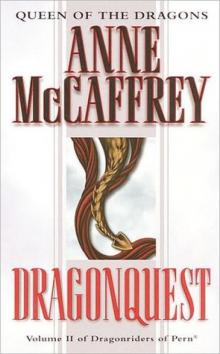 Dragonquest
Dragonquest Moreta (Dragonlady of Pern)
Moreta (Dragonlady of Pern)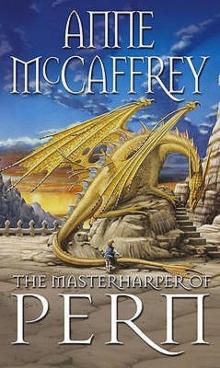 The Masterharper of Pern
The Masterharper of Pern If Wishes Were Horses
If Wishes Were Horses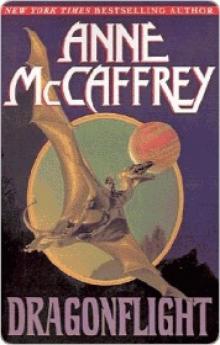 Dragonflight
Dragonflight No One Noticed the Cat
No One Noticed the Cat The White Dragon
The White Dragon A Gift of Dragons
A Gift of Dragons Harper Hall - Dragonsong
Harper Hall - Dragonsong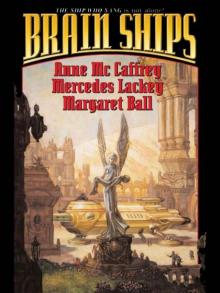 Brain Ships
Brain Ships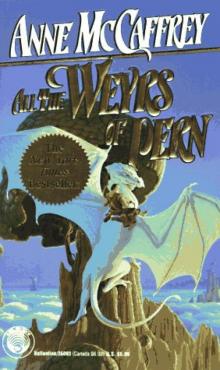 All The Weyrs of Pern
All The Weyrs of Pern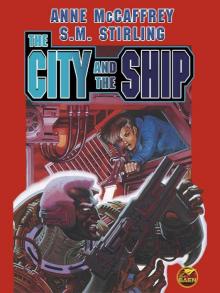 The City and the Ship
The City and the Ship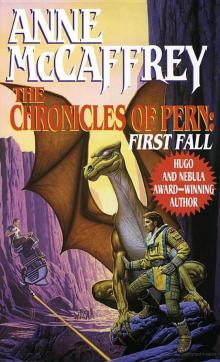 The Chronicles of Pern: First Fall
The Chronicles of Pern: First Fall Acorna’s Search
Acorna’s Search Powers That Be
Powers That Be Second Wave
Second Wave Chronicles of Pern (First Fall)
Chronicles of Pern (First Fall) The Kilternan Legacy
The Kilternan Legacy Decision at Doona
Decision at Doona Dragondrums (dragon riders of pern)
Dragondrums (dragon riders of pern) Dragonsinger (dragon riders of pern)
Dragonsinger (dragon riders of pern) The Master Harper of Pern
The Master Harper of Pern Crystal Singer
Crystal Singer Acorna’s People
Acorna’s People Pegasus in Flight
Pegasus in Flight Sky Dragons Dragonriders of Pern
Sky Dragons Dragonriders of Pern Dragonriders of Pern 4 - Dragonsinger
Dragonriders of Pern 4 - Dragonsinger Treaty at Doona
Treaty at Doona Damia's Children
Damia's Children Stitch In Snow
Stitch In Snow The Rowan
The Rowan Dinosaur Planet
Dinosaur Planet The Year of the Lucy
The Year of the Lucy The White Dragon p-4
The White Dragon p-4 Power Lines
Power Lines Catacombs
Catacombs Moreta
Moreta Dragonsinger
Dragonsinger Crystal Line
Crystal Line The Renegades of Pern
The Renegades of Pern Moreta - Dragonlady of Pern p-8
Moreta - Dragonlady of Pern p-8 Deluge
Deluge The Skies of Pern
The Skies of Pern Acorna's Quest
Acorna's Quest Dragon's Kin
Dragon's Kin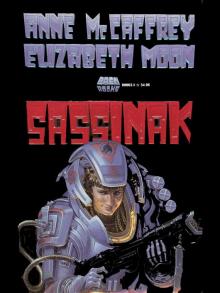 Sassinak
Sassinak![Crystal Universe - [Crystal Singer 03] - Crystal Line Read online](http://i1.bookreadfree.com/i1/03/31/crystal_universe_-_crystal_singer_03_-_crystal_line_preview.jpg) Crystal Universe - [Crystal Singer 03] - Crystal Line
Crystal Universe - [Crystal Singer 03] - Crystal Line Freedom's Landing
Freedom's Landing Acorna’s Quest
Acorna’s Quest Masterharper of Pern
Masterharper of Pern Restoree
Restoree Dolphins of Pern
Dolphins of Pern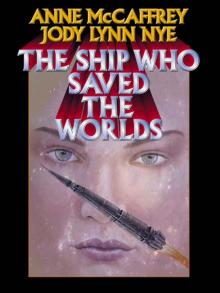 The Ship Who Saved the Worlds
The Ship Who Saved the Worlds Acorna's Triumph
Acorna's Triumph Acorna's Rebels
Acorna's Rebels![[Acorna 08] - First Warning: Acorna's Children (with Elizabeth Ann Scarborough) Read online](http://i1.bookreadfree.com/i1/04/06/acorna_08_-_first_warning_acornas_children_with_elizabeth_ann_scarborough_preview.jpg) [Acorna 08] - First Warning: Acorna's Children (with Elizabeth Ann Scarborough)
[Acorna 08] - First Warning: Acorna's Children (with Elizabeth Ann Scarborough) Dragonsong (dragon riders of pern)
Dragonsong (dragon riders of pern) Dragonriders of Pern 6 - Dragondrums
Dragonriders of Pern 6 - Dragondrums The Death of Sleep
The Death of Sleep Crisis On Doona
Crisis On Doona Nimisha's Ship
Nimisha's Ship Black Horses for the King
Black Horses for the King Changelings
Changelings Freedom's Choice
Freedom's Choice The Lady
The Lady The Coelura
The Coelura Catalyst
Catalyst The Unicorn Girl
The Unicorn Girl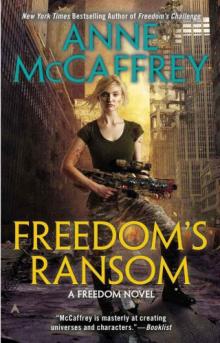 Freedom's Ransom
Freedom's Ransom Nerilka's Story
Nerilka's Story Dragon's Fire
Dragon's Fire Generation Warriors
Generation Warriors Lyon's Pride
Lyon's Pride Dragonseye
Dragonseye Dragon Quest
Dragon Quest Dragondrums
Dragondrums Dragonsong
Dragonsong The Mystery of Ireta
The Mystery of Ireta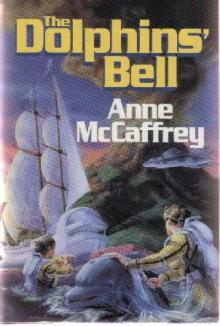 Dolphins' Bell
Dolphins' Bell To Ride Pegasus
To Ride Pegasus Power Play
Power Play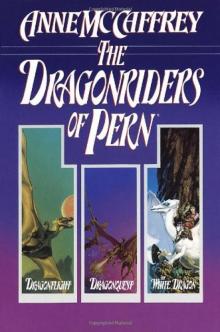 The Dragonriders of Pern
The Dragonriders of Pern An Exchange of Gifts
An Exchange of Gifts The Ship Who Sang
The Ship Who Sang Sky Dragons: Dragonriders of Pern
Sky Dragons: Dragonriders of Pern Maelstrom
Maelstrom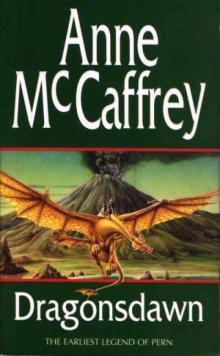 Dragons Dawn
Dragons Dawn Dragon Song
Dragon Song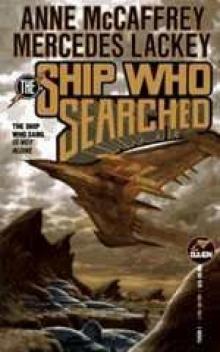 The Ship Who Searched b-3
The Ship Who Searched b-3 Damia
Damia Freedom's Challenge
Freedom's Challenge